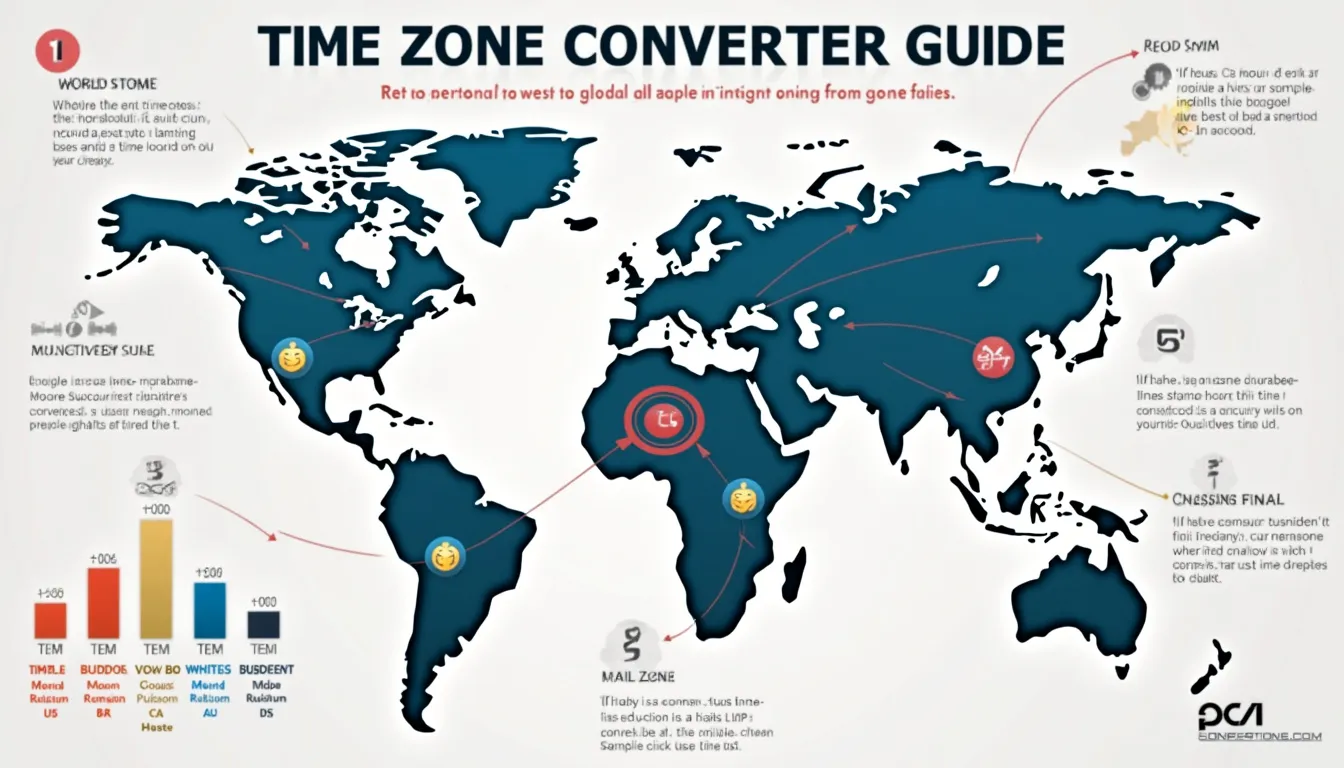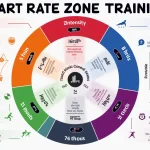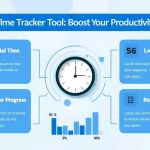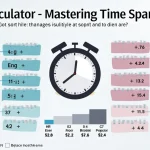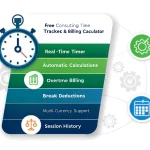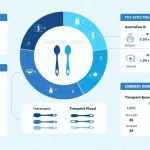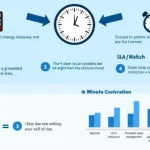Time Zone Converter
Is this tool helpful?
How to Use the Time Zone Converter Effectively
Step-by-Step Instructions
Use the Time Zone Converter to quickly and accurately convert times between different global time zones by following these simple steps:
- Select Date: Use the date picker to choose the date you want to convert. Example: December 5, 2023 or July 14, 2024.
- Enter Time: Input the time in 24-hour format using the time picker. For instance, enter 09:45 or 20:15.
- Choose Source Time Zone: Select the original time zone where your input time is based. Examples: Europe/Paris (CET/CEST), Asia/Tokyo (JST).
- Select Target Time Zone: Pick the time zone you want to convert to. Examples: America/Los_Angeles (PST/PDT), Australia/Sydney (AEST/AEDT).
- Click Convert: Submit the form to see the converted time displayed, accounting for any daylight saving time or date changes.
The converter will show you the exact equivalent date and time in both the source and target time zones, allowing you to schedule meetings or events across regions without confusion.
Example Inputs and Outputs
- Input: Date: 2023-12-05, Time: 09:45, Source: Europe/Paris, Target: Asia/Tokyo
- Output: December 5, 2023, 9:45 AM CET (Europe/Paris) is equivalent to December 5, 2023, 5:45 PM JST (Asia/Tokyo)
- Input: Date: 2024-07-14, Time: 20:15, Source: Australia/Sydney, Target: America/Los_Angeles
- Output: July 14, 2024, 8:15 PM AEST (Australia/Sydney) is equivalent to July 14, 2024, 3:15 AM PDT (America/Los_Angeles)
Understanding the Time Zone Converter: Definition, Purpose, and Key Benefits
What is a Time Zone Converter?
A Time Zone Converter is an essential online tool designed to calculate the equivalent time between two different time zones worldwide. It simplifies the complexity of global time differences, including adjustments for Daylight Saving Time (DST), varying time offsets, and cross-date line calculations.
Purpose of the Time Zone Converter
The main goal of this tool is to provide users with fast, precise, and reliable conversions between any two global time zones by considering:
- Standard UTC offsets for each time zone
- Automatic daylight saving time changes
- Date shifts caused by the International Date Line
- Uncommon time zone offsets such as 30 or 45-minute differences
This ensures that international communications, travel planning, and event scheduling happen smoothly and without timing errors.
Benefits of Using This Time Zone Converter
- Accurate Time Conversion: Removes guesswork by correctly factoring in daylight saving and local time rules.
- Efficient Planning: Saves time by instantly providing precise results for scheduling and coordination.
- Improves Global Communication: Makes setting up international meetings and conferences hassle-free.
- Travel Convenience: Helps travelers adapt to new time zones and plan activities accordingly.
- Boosts Business Productivity: Enhances collaboration for companies operating across multiple regions.
- Event Coordination: Ensures worldwide event timings align perfectly across different zones.
- Educational Value: Aids learning about global time zones and geographic time variations.
Example Time Zone Conversion Calculations
How the Converter Handles Complex Scenarios
1. Cross-Date Line Time Conversion
Crossing the International Date Line often causes changes in the calendar date during time conversion. For example:
- Input: Date: 2023-12-31, Time: 23:00, Source: Pacific/Honolulu, Target: Asia/Tokyo
- Output: December 31, 2023, 11:00 PM HST is equivalent to January 1, 2024, 6:00 PM JST
2. Daylight Saving Time Transitions
The tool automatically accounts for DST changes, avoiding confusion. For example:
- Input: Date: 2023-03-12, Time: 02:30, Source: America/New_York (DST start day), Target: Europe/London
- Output: March 12, 2023, 2:30 AM EST is equivalent to March 12, 2023, 7:30 AM GMT
3. Non-Standard Time Zone Offsets
Regions with 30 or 45-minute offsets are handled accurately. Example:
- Input: Date: 2024-01-10, Time: 14:15, Source: Asia/Kathmandu (+5:45), Target: Australia/Eucla (+8:45)
- Output: January 10, 2024, 2:15 PM NPT is equivalent to January 10, 2024, 5:15 PM ACWST
Mathematical Basis of Time Zone Conversion
At its core, time zone conversion is based on calculating the difference between UTC offsets of the source and target zones, while considering special cases such as DST and date boundaries.
This formula is dynamically adjusted in the converter’s algorithms to ensure all conversions reflect real-world time zone rules.
Practical Applications and Real-World Use Cases
1. Scheduling International Business Meetings
Companies working across multiple countries can use this tool to coordinate meetings, ensuring all participants join at convenient local times. For example, a conference call might include:
- New York: March 15, 2024, 10:00 AM EDT
- London: March 15, 2024, 3:00 PM GMT
- Hong Kong: March 15, 2024, 11:00 PM HKT
2. Travel Itinerary Planning
Travelers can plan flight times, hotel check-ins, and activities by understanding local times at departure and destination points. For example:
- Departure (London): June 5, 2024, 7:30 AM BST
- Arrival (New Delhi): June 5, 2024, 8:00 PM IST
3. Managing Global Events and Webinars
Event organizers can synchronize event start times across various regions worldwide, ensuring all invitees receive correct scheduling information.
4. Facilitating Academic and Research Collaborations
Teams spanning multiple time zones can use the converter to set recurring meetings and deadlines that accommodate everyone’s local time constraints.
Frequently Asked Questions (FAQ) About Time Zone Conversion
1. How does the converter manage daylight saving time?
The tool automatically adjusts conversions based on current DST rules for the selected date and regions, ensuring accurate results throughout the year.
2. Can I convert more than two time zones at once?
Currently, the converter is designed for pairwise conversions between one source and one target time zone. To convert multiple zones, perform separate calculations for each target.
3. How frequently is the time zone information updated?
The time zone database is regularly maintained to reflect changes in political time zone policies or DST adjustments globally.
4. Why do some time zones use offsets like +5:30 or +8:45?
Some regions adopt fractional hour offsets to better align with local solar time or historical conventions. The converter accurately incorporates these unique offsets.
5. Is the converter suitable for historical date calculations?
The tool focuses on current and future dates. Historical time zone and DST changes may not be reflected precisely due to varying past policies.
6. How are time zones without daylight saving time handled?
For regions that don’t observe DST, the converter maintains a consistent standard offset all year round.
7. What distinguishes GMT from UTC in this context?
While GMT and UTC are often used interchangeably, UTC is the global time standard used as the reference for conversions in this tool.
8. How does the International Date Line affect conversion?
The tool automatically shifts the date when converting across the International Date Line to ensure time accuracy and avoid confusion.
9. Can I use this tool for scheduling recurring events?
Yes, but consider that DST changes may cause local time changes during the year, so verify recurring event times seasonally.
10. How do I select the correct time zone for locations near border areas?
Always select the official time zone corresponding to the city or region of interest. The converter provides widely recognized zones to simplify your choice.
By leveraging this comprehensive Time Zone Converter, users can manage global schedules with confidence, streamline international coordination, and avoid the pitfalls of time zone confusion.
Important Disclaimer
The calculations, results, and content provided by our tools are not guaranteed to be accurate, complete, or reliable. Users are responsible for verifying and interpreting the results. Our content and tools may contain errors, biases, or inconsistencies. We reserve the right to save inputs and outputs from our tools for the purposes of error debugging, bias identification, and performance improvement. External companies providing AI models used in our tools may also save and process data in accordance with their own policies. By using our tools, you consent to this data collection and processing. We reserve the right to limit the usage of our tools based on current usability factors. By using our tools, you acknowledge that you have read, understood, and agreed to this disclaimer. You accept the inherent risks and limitations associated with the use of our tools and services.
